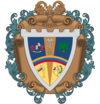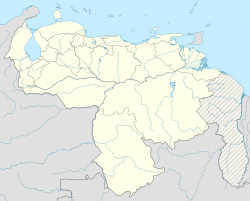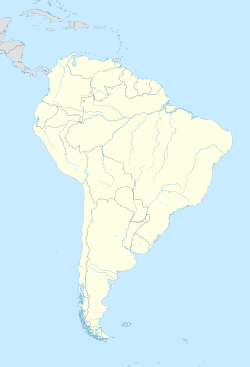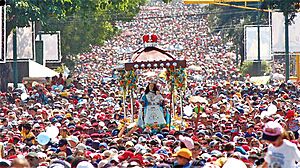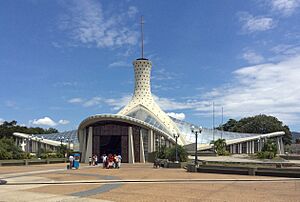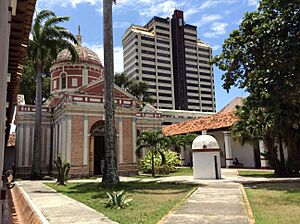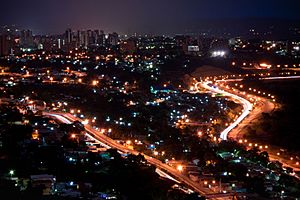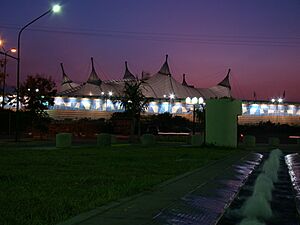Barquisimeto facts for kids
Quick facts for kids
Barquisimeto
|
|||
|---|---|---|---|
| Nueva Segovia de Barquisimeto | |||
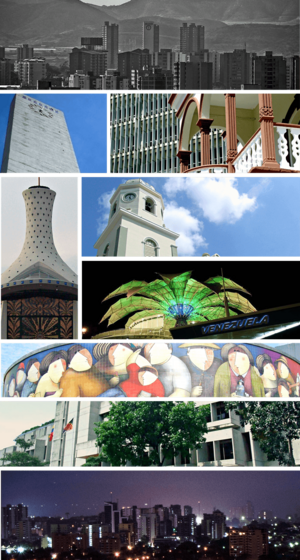
Top:Skyline view of West Barrio Nuevo area, Second:Obelisk of Barquisimento, Barquisimento Municipal Tower and Casa de Eustaquio Gomez (Eustaquio Gomez House), (left to right) Third:Barquisimento Metropolitan Cathedral, Santa Rosa Church, Flower of Venezuela, (left to lower right) Fourth:Centroccidential Lisandro Alvarado University, Fifth:Barquisimento Government Palace, Bottom:Night view of central Carrera area
|
|||
|
|||
| Nickname(s):
"Capital musical de Venezuela" (English: " Musical capital of Venezuela) " " Ciudad Crepuscular" (English: "Twilight City")
|
|||
| Country | |||
| State | Lara | ||
| Municipality | Iribarren | ||
| Founded | 1552 | ||
| Founded by | Juan de Villegas | ||
| Area | |||
| • City | 276 km2 (107 sq mi) | ||
| • Urban | 194 km2 (75 sq mi) | ||
| Elevation | 566 m (1,857 ft) | ||
| Population
(2022)
|
|||
| • City | 1,240,714 | ||
| • Demonym | Barquisimetan guaro/a | ||
| Time zone | UTC−4 (VET) | ||
| Postal code |
3001 - 3023
|
||
| Area code(s) | 0251 | ||
| Climate | BSh | ||
| Website | Local Government Website | ||
| The area and population figures are for the municipality | |||
Barquisimeto is a lively city in Venezuela. It's known as the "Musical Capital of Venezuela" and also the "Twilight City." This city is the capital of the Lara state. It's a very important place for business, industry, and transportation in the country. Barquisimeto is the fourth-largest city in Venezuela by how many people live there and its size.
Contents
History of Barquisimeto
Barquisimeto was founded in 1552 by a man named Juan de Villegas. He wanted a good spot to control the area, which people thought had lots of gold. The city was first called Nueva Segovia de Barquisimeto. Later, its name was made shorter to just Barquisimeto.
The city actually moved four times between 1552 and 1563! The first spot was near the Buría River. But it flooded often, so they moved in 1556. The second place was in the Turbio River valley. However, a rebel named Lope de Aguirre burned it down in 1561.
The city was rebuilt about 102 kilometers away. But in 1562, people asked to move again because of strong winds. Finally, in 1563, Barquisimeto found its permanent home. This was on a flat area north of the Turbio River.
During Venezuela's fight for independence, Barquisimeto joined in. Its representative, José Ángel Álamo, signed the Independence Act on July 5, 1811. This was a big step for the country's freedom.
In 1929, the city got a big makeover. General Juan Vicente Gomez led a modernization plan. He improved streets and built new buildings. Important places like the Jacinto Lara Headquarters and the Government Palace were built then.
What Does the Name Barquisimeto Mean?
The name Barquisimeto has an interesting past. A German explorer, Nikolaus Federmann, said the native Caquetío people called it "Variquicimeto." This word meant "ash-colored river." They used this name for the river near the city. The Spanish later called this river the "Turbio River," which it is still called today. Another idea is that the name comes from a red dye called bariquí.
When Juan de Villegas first founded the city, he named it "Nueva Segovia de Barquisimeto." But over the years, people started calling it just "Barquisimeto." This shorter name became very popular.
Religion and Faith
The main church in the city is the modern Cathedral of Our Lady of Mount Carmel. It's the most important Catholic church in the area.
The Divina Pastora
The Divina Pastora is a special statue of the Virgin Mary. She holds baby Jesus and has a lamb by her side. Many people in Venezuela believe she is very important. She is the patron saint of Barquisimeto. She is also the patron saint of the Venezuelan National Militia. The original statue was made in 1735.
Every year on January 14, there is a huge procession for the Divina Pastora. Thousands of people come to honor her. It's one of the biggest Marian processions in the world. The statue is carried from its church in Santa Rosa to the Barquisimeto Cathedral. This is different from other similar events. Usually, the statue stays in its church.
The people of Barquisimeto have a special reason for this procession. They do it to thank the Divina Pastora. They believe she saved the city from a serious sickness in the 1800s. In 2013, about 3 million people joined this special event.
Geography and Location
Barquisimeto is located on a flat area next to the Turbio River. It is about 566 meters (1,857 feet) above sea level. The city is in the central-western part of Venezuela. It's about 363 kilometers (226 miles) from Caracas, the capital city.
Barquisimeto is a meeting point for many major roads and train lines. The city is famous for its organized streets. They are numbered in order, which makes it easy for visitors to find their way around. The weather is nice from December to March. The average temperature is about 26°C (79°F) all year.
Nearby Areas
- North: Urdaneta Municipality
- South: Palavecino Municipality
- East: Peña Municipality, Yaracuy State
- West: Jiménez and Torres Municipalities.
Earthquakes in Barquisimeto
Barquisimeto has experienced some strong earthquakes. Here are a few notable ones:
- 6.6 magnitude (August 3, 1950)
- 5.6 magnitude (March 5, 1975)
- 6.3 magnitude (September 12, 2009)
Climate of Barquisimeto
Barquisimeto has a hot, semi-dry climate. This means it doesn't get a lot of rain. The city usually gets about 550 millimeters (21.7 inches) of rain each year. The average temperature is around 25°C (77°F). However, in higher areas closer to the Andes mountains, it's cooler. These areas also get more rain. For example, Sanare city gets about 835 millimeters (32.9 inches) of rain each year.
| Month | Jan | Feb | Mar | Apr | May | Jun | Jul | Aug | Sep | Oct | Nov | Dec | Year |
|---|---|---|---|---|---|---|---|---|---|---|---|---|---|
| Record high °C (°F) | 38.0 (100.4) |
36.6 (97.9) |
39.4 (102.9) |
35.9 (96.6) |
35.6 (96.1) |
35.9 (96.6) |
35.9 (96.6) |
39.6 (103.3) |
36.3 (97.3) |
34.8 (94.6) |
35.2 (95.4) |
33.9 (93.0) |
39.6 (103.3) |
| Mean daily maximum °C (°F) | 30.9 (87.6) |
31.8 (89.2) |
32.3 (90.1) |
31.8 (89.2) |
31.3 (88.3) |
30.6 (87.1) |
30.4 (86.7) |
31.1 (88.0) |
31.5 (88.7) |
30.9 (87.6) |
30.7 (87.3) |
30.5 (86.9) |
31.1 (88.0) |
| Daily mean °C (°F) | 23.5 (74.3) |
24.0 (75.2) |
24.7 (76.5) |
25.1 (77.2) |
25.0 (77.0) |
24.3 (75.7) |
24.0 (75.2) |
24.3 (75.7) |
24.7 (76.5) |
24.5 (76.1) |
24.3 (75.7) |
23.8 (74.8) |
24.4 (75.9) |
| Mean daily minimum °C (°F) | 19.1 (66.4) |
19.4 (66.9) |
20.3 (68.5) |
21.4 (70.5) |
21.6 (70.9) |
21.2 (70.2) |
20.9 (69.6) |
21.0 (69.8) |
21.2 (70.2) |
21.2 (70.2) |
21.0 (69.8) |
20.0 (68.0) |
20.7 (69.3) |
| Record low °C (°F) | 13.4 (56.1) |
13.2 (55.8) |
12.6 (54.7) |
15.2 (59.4) |
16.5 (61.7) |
16.1 (61.0) |
16.4 (61.5) |
15.4 (59.7) |
15.4 (59.7) |
11.1 (52.0) |
15.0 (59.0) |
13.8 (56.8) |
11.1 (52.0) |
| Average rainfall mm (inches) | 12.1 (0.48) |
9.7 (0.38) |
18.6 (0.73) |
52.1 (2.05) |
59.2 (2.33) |
75.5 (2.97) |
61.6 (2.43) |
56.3 (2.22) |
50.7 (2.00) |
72.1 (2.84) |
58.1 (2.29) |
39.8 (1.57) |
565.8 (22.28) |
| Average rainy days (≥ 1.0 mm) | 2.4 | 1.5 | 2.3 | 6.2 | 7.6 | 11.6 | 10.4 | 8.9 | 7.0 | 8.8 | 6.2 | 5.4 | 78.3 |
| Average relative humidity (%) | 68.5 | 66.5 | 65.5 | 70.0 | 74.0 | 75.0 | 74.5 | 73.0 | 72.5 | 73.0 | 73.0 | 72.0 | 71.5 |
| Mean monthly sunshine hours | 260.4 | 235.2 | 241.8 | 183.0 | 192.2 | 201.0 | 232.5 | 241.8 | 228.0 | 226.3 | 222.0 | 248.0 | 2,712.2 |
| Mean daily sunshine hours | 8.4 | 8.4 | 7.8 | 6.1 | 6.2 | 6.7 | 7.5 | 7.8 | 7.6 | 7.3 | 7.4 | 8.0 | 7.4 |
| Source 1: NOAA (sun 1971–1990) | |||||||||||||
| Source 2: Instituto Nacional de Meteorología e Hidrología (humidity 1970–1998) | |||||||||||||
Education and Universities
Barquisimeto is a city that loves learning. It has many universities and colleges. A large and growing number of students from all over Venezuela come here to study.
Some of the main universities are Universidad Centroccidental Lisandro Alvarado and Universidad Nacional Experimental Politécnica Antonio José de Sucre.
Other Universities and Colleges
- Public Schools
- Universidad Centroccidental Lisandro Alvarado (UCLA)
- National Polytechnic Experimental University Antonio José de Sucre (UNEXPO)
- Libertador's Experimental and Pedagogical University (UPEL)
- Andrés Eloy Blanco's Territorial and Polytechnic of Lara University (IUETAEB)
- National Open University (UNA)
- Simón Rodríguez's National Experimental University (UNESR)
- Central University of Venezuela (UCV - Barquisimeto's Regional Center)
- Bolivarian University of Venezuela (UBV)
- National Experimental University of the Armed Forces (UNEFA)
- Private Schools
- Fermin Toro University (UFT)
- Yacambú University (UNY)
- Fermin Toro College (CUFT)
- Rodolfo Loero Arismendi Technology and Industrial Institute (IUTIRLA)
- National Institute of Socialist Education and Capacitation (INCES)
- Antonio José de Sucre Technology Institute (IUTAJS)
- Jesús Obrero Institute (IUJO)
Hospitals in Barquisimeto
Barquisimeto has several hospitals to care for its residents. These include both private and public medical centers.
Private Hospitals
- Clínica IDB Barquisimeto
- Clínica Razetti de Barquisimeto
- Policlínica Barquisimeto
- Previmédica IDB Los Abogados
- Previmédica IDB Centro
- Previmédica IDB Oeste
Public Hospitals
- Hospital Central Universitario Antonio María Pineda
- Hospital Dr. Luis Gómez López
Getting Around: Transportation
The city has a transportation system called Transbarca. It's a "bus rapid transit" (BRT) system. This means buses have their own special lanes. The system was planned to carry many people each day. It was designed to use 80 special buses on 30 kilometers (19 miles) of lanes.
The plan also included 52 stations. These stations would be easy for older people and those with disabilities to use. Smaller "feeder" routes would connect to the main line. These would help people from areas not directly on the main route.
Even though 80 special buses were bought, the plan changed. In 2013, they decided not to use those buses. One reason was the cost. Another was that there wasn't enough electricity to power the system.
- Buses are the main way people travel around the city. Different types of buses are used by various companies:
- Bus: These are large buses.
- Buseta: These are medium-sized buses.
- Microbus or colectivo: These are vans or minivans.
- Rapiditos: These are older cars that can carry 5 or more people.
Barquisimeto also has an airport. It's called Jacinto Lara International Airport.
Sports Teams
Barquisimeto is home to several popular sports teams. You can find both baseball and football teams here. Other sports also have teams based in the city.
- Cardenales de Lara (Lara Cardinals) - This is a baseball team in the Venezuelan Professional Baseball League.
- Guaros de Lara - This is a basketball team in the Venezuelan Professional Basketball League.
- Lara FC - This is a football (soccer) team in the Venezuelan Professional Soccer League.
Famous People from Barquisimeto
Many talented people come from Barquisimeto. Here are a few:
- Junior Alvarado (born 1986) - A professional horse racing jockey.
- Rafael Cadenas (born 1930) - A poet and essay writer. He won a big award called the Cervantes prize in 2022.
- Gregorio Camacho (1933–2002) - A well-known painter.
- Carlos Carrasco (born 1987) - A baseball pitcher for the Cleveland Guardians in Major League Baseball.
- Gustavo Dudamel (born 1981) - A famous conductor and violinist.
- Andrés Giménez (born 1998) - A Major League Baseball player for the Cleveland Guardians.
- Amleto Monacelli (born 1961) - A professional ten-pin bowler.
- Manny Piña (born 1987) - A Major League Baseball player for the Atlanta Braves.
Images for kids
See also
 In Spanish: Barquisimeto para niños
In Spanish: Barquisimeto para niños



